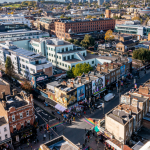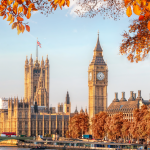National-level inflation figures highlight the unprecedented pressure on the cost of living faced by the cities surveyed.
Inflation over the past year was highest in the US, at 8.5% for the year ending in March 2022 – the largest increase since December 1981.[1] This was followed by the UK, Germany and France, where inflation had been lower. Other data shows Hong Kong enjoyed among the lowest rates of our global cities in 2021, which seems to have continued into early 2022, potentially enabled by the city’s increasing economic isolation.[2]
Energy prices have played a key role in these price increases – from Q3 2021 to Q1 2024 the UK saw energy prices rise from a 9.6% annualised rate of inflation to 24.5%, as the Russian invasion of Ukraine roiled international energy markets. For domestic energy consumers, this was most keenly felt in April, when the energy price cap rose by 54%. Given the lack of energy caps for business and industry in the UK, high wholesale energy prices will further increase price pressures on consumer goods and some service sector activity with time.
France has seen a lower rise in energy prices, as the French state has for now, introduced a strong “tariff shield” against price rises, which are currently capped at 38 euros a year for households.[3] French state control of major energy firms and the predominance of domestic nuclear power in the country’s energy mix have made this possible to date, but there is a question as to how long this policy can remain in effect if global energy prices remain high.
There is extensive debate surrounding the causes of all this inflation – clearly, the war in Ukraine has had a profound impact on supply chains for food and raw materials while sanctions on Russia have materially impacted energy markets. This has combined with the aftershocks of coronavirus across global supply chains – stringent lockdowns in China have exacerbated existing shortages in labour and goods. Others, such as the chairman of NatWest, have pointed to the contribution from monetary expansion including quantitative easing.[4]
Since the end of Q1 2022 (March), inflation has increased even further, hitting 9% in the UK in May, the highest rate for 40 years.
[1] https://www.bls.gov/opub/ted/2022/consumer-prices-up-8-5-percent-for-year-ended-march-2022.htm
[2] https://data.imf.org/?sk=4c514d48-b6ba-49ed-8ab9-52b0c1a0179b&sId=1501617220735
[3] https://www.euractiv.com/section/energy/news/increase-in-electricity-prices-inevitable-says-french-elected-official/
[4] https://www.thetimes.co.uk/article/bank-of-england-should-have-moved-sooner-to-curb-inflation-says-ex-central-banker-davies-btclp8820


